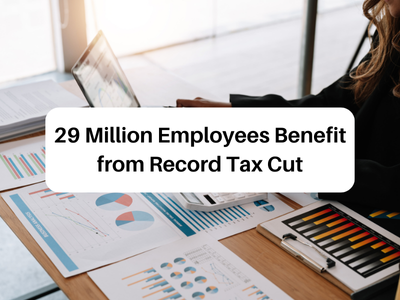29 Million Workers Receive Largest Ever Tax Cut to National Insurance in the United Kingdom
 The United Kingdom government is implementing the most significant tax cut in national insurance contributions (NICs) in history. The program is set to give £900 boost to the annual income of a typical worker.
The United Kingdom government is implementing the most significant tax cut in national insurance contributions (NICs) in history. The program is set to give £900 boost to the annual income of a typical worker.
Since the autumn of 2023, NICs for workers have been sliced by a third, marking an unparalleled milestone in tax reduction. The aim? To eventually eliminate the inequitable burden of double taxation on labour, with aspirations to completely dismantle employee and self-employed NICs.
A Historic Tax Relief
January ushered in a pivotal phase, as the primary rate of employee National Insurance plummeted from 12% to 8% for 27 million workers, translating to substantial savings for those earning around £35,400. Simultaneously, over 2 million self-employed individuals rejoiced as the primary rate of Class 4 NICs saw a reduction from 9% to 6%, coupled with the eradication of the Class 2 NICs recruitment. This overhaul not only simplifies the tax framework but also promises an average annual saving of £650 for self-employed persons.
Government’s Economic Endeavour
These sweeping tax reductions are made feasible by the economic resurgence witnessed across the nation. Inflation, once soaring at 11.1%, has been reined in to 3.4%, while borrowing costs have begun their descent. This economic trajectory enables the government to alleviate the tax burden on its citizens, fostering both economic growth and a climate of rewarding hard work.
Prime Minister Rishi Sunak articulated the sentiment, emphasising the inherent value of diligence and the tangible dividends it now yields. Chancellor of the Exchequer, Jeremy Hunt, echoed this sentiment, heralding the tax cuts as emblematic of the administration’s steadfast support for the workforce and its commitment to rectifying the unfairness of double taxation.
Empowering Families
Beyond individual gains, these tax alleviations are poised to invigorate the economy by incentivising greater labour market participation. The Office for Budget Responsibility (OBR) anticipates a surge in total hours worked equivalent to nearly 200,000 full-time employees by 2028-29, affirming the ripple effect of these reforms.
Furthermore, HMRC’s revamped online tool stands as a beacon of accessibility, aiding individuals in discerning their personal savings in National Insurance. Coinciding with this fiscal overhaul is an elevation of the income threshold for the High Income Child Benefit Charge (HICBC), liberating 170,000 families from its clutches and lightening the financial load for 485,000 hard-working families, who stand to benefit from an average yearly sum of £1,260 towards child-rearing expenses.
Who Does This Help?
The combined impact of National Insurance cuts extends its benefits across various sectors:
- Families with multiple earners, nurses, police officers, cleaners, doctors, plumbers, teachers, and more stand to gain significantly from these measures.
- Couples with school-aged children and single-earner households also reap substantial annual gains, injecting vitality into household finances.
Conclusion
As the fiscal landscape undergoes transformation, the government’s unwavering dedication to the welfare of its citizens manifests in tangible relief measures. From tax cuts to enhanced support for hard-working families, these initiatives herald a new era of economic empowerment and resilience.
For those eager to calculate their potential NICs savings or explore further support avenues, HMRC’s online tool and the government’s cost of living support website stand ready to assist.
For personalized tax consultation and expert financial advice, consider reaching out to 3E Accounting, your trusted corporate service provider.

